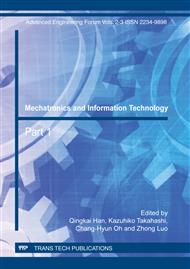[1]
Graham Wild, Acousto-Ultrasonic Optical Fiber Sensors: Overview and State-of-the-Art, J. IEEE SENSORS JOURNAL. 2008, 8(7): 1184-1193.
DOI: 10.1109/jsen.2008.926894
Google Scholar
[2]
Zhang Haiyan, Ultrasonic Lamb Wave Inspection Using Fiber Bragg Gratings, J. Microwave Conference. 2008, 10(12):805-808.
DOI: 10.1109/cjmw.2008.4772550
Google Scholar
[3]
Pavel Fomitchov, Response of a fiber Bragg grating ultrasonic sensor, J. Optical Engineering. 2003, 42(4): 956-963.
DOI: 10.1117/1.1556372
Google Scholar
[4]
Hiroshi Tsuda, Ultrasonic and damage detection in CFRP using fiber Bragg grating sensors, J. Composites Science and Technology. 2006, (66): 676-683.
DOI: 10.1016/j.compscitech.2005.07.043
Google Scholar
[5]
Hiroshi Tsuda, Jung-Ryul Lee, Investigation of fatigue crack in stainless steel using a mobile fiber Bragg grating ultrasonic sensor, J. Optical Fiber Technology. 2007, (13): 209-214.
DOI: 10.1016/j.yofte.2006.12.003
Google Scholar
[6]
Jung-Ryul Lee, Hiroshi Tsuda, Impact wave and damage detection using a strain-free fiber Bragg grating ultrasonic receiver, J. NDT&E International, 2007, (40): 85-93.
DOI: 10.1016/j.ndteint.2006.07.001
Google Scholar
[7]
Pou-Man Lan, Acousto-ultrasonic sensing for delaminated GFRP composites using an embedded FBG sensor, J. Optics and Laser in Engineering. 2009, (47): 1049-1055.
DOI: 10.1016/j.optlaseng.2009.01.010
Google Scholar
[8]
Nobuuo Takeda, Yoji Okabe, Development of smart composite structures with small-diameter fiber Bragg grating sensors for damage detection: Quantitative evaluation of delamination length in CFRP laminates using Lamb wave sensing, J. Composites Science and Technology. 2005, (65): 2575-2587.
DOI: 10.1016/j.compscitech.2005.07.014
Google Scholar
[9]
Jung-Ryul Lee, A novel fiber Bragg grating acoustic emission sensor head for mechanical tests, J. Scripta Materialia. 2005, (53): 1181-1186.
DOI: 10.1016/j.scriptamat.2005.07.018
Google Scholar
[10]
Toshimichi Ogisu, Feasibility studies on active damage detection for CFRP aircraft bonding structures, J. Advanced Composite Materials. 2006, 15(2): 153-173.
DOI: 10.1163/156855106777873923
Google Scholar
[11]
Graham Wild, Spatial Performance of Acousto-Ultrasonic Fiber Bragg Grating Sensor, J. IEEE Sensors Journal. 2010, 10(4): 805-806.
DOI: 10.1109/jsen.2009.2038232
Google Scholar


